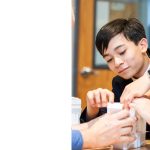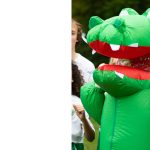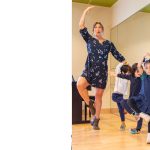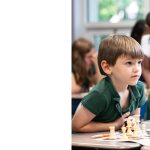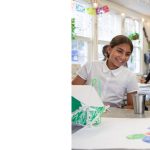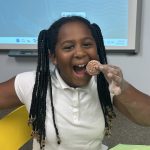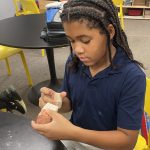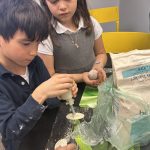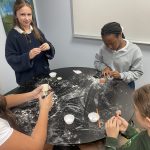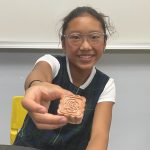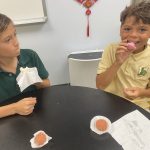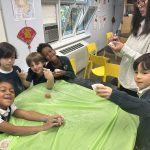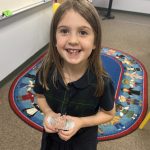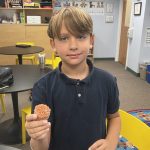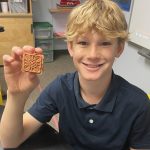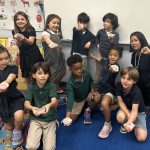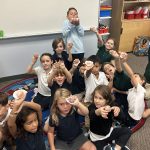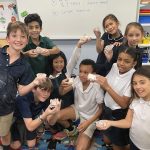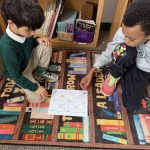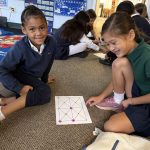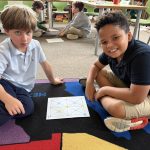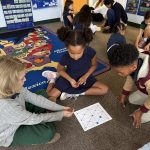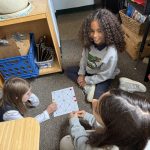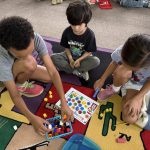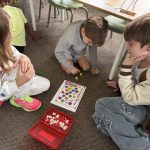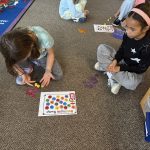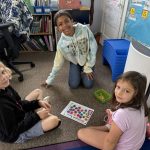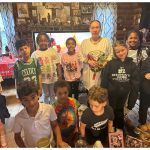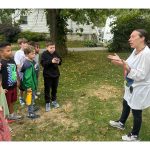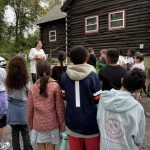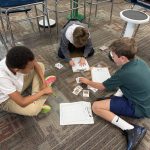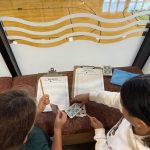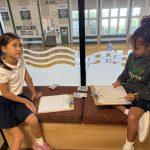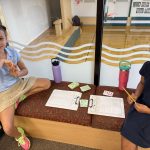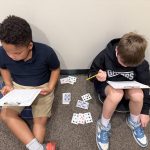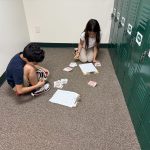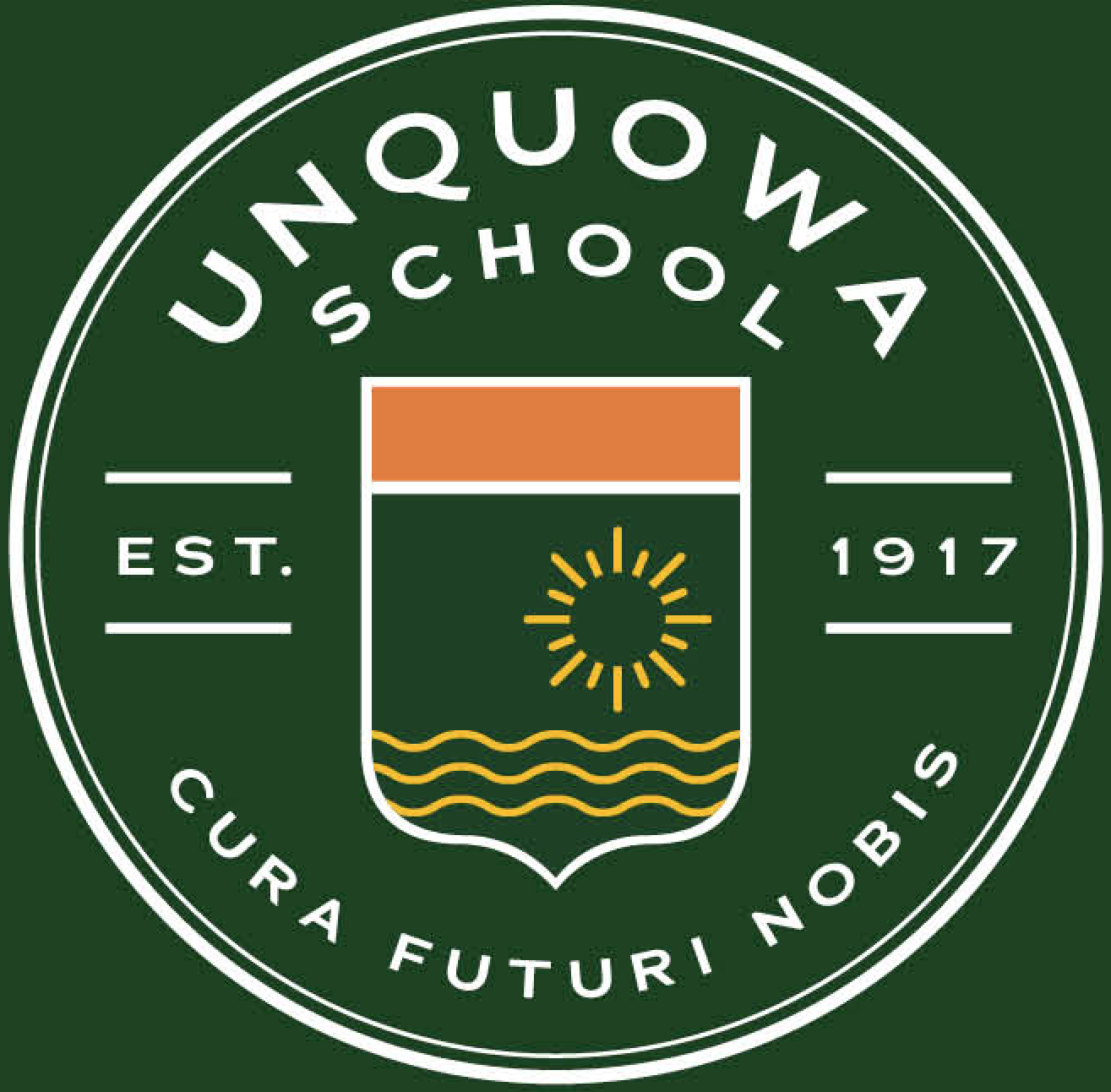中秋节快乐Zhōng qiū jié kuài lè – Happy Mid-Autumn Festival
Posted by Carina BlackwellIt’s that time of year again! Both Lower and Upper School Mandarin students celebrated the Mid-Autumn Festival — a joyful occasion that usually falls on the 15th day of the 8th lunar month, during the time of the fullest and brightest moon. Students made mooncakes out of clay, and Upper School students also tasted mochi!
This year, students used clay instead of real dough to press into the mooncake molds. They could choose from two shapes — square or round — and everyone was excited to see their own creations emerge from the mold. They loved this cultural class and hands-on activity. Some students even said they were going to bring their clay mooncakes home to trick their siblings and parents into taking a bite!
Upper School students enjoyed tasting the mochi, noting how the outside had a chewy dough-like texture while the inside was filled with ice cream.
Students also enjoyed learning that the festival honors the legendary hero Hou Yi and his wife, who is said to have gone to the moon, leaving him heartbroken. To express his love and longing, Hou Yi prepared a feast with mooncakes for dessert. The round shape of the mooncake symbolizes reunion, making this holiday similar to Thanksgiving — a time for families to gather, share delicious food, and appreciate the full moon together. In some areas, people fly lanterns to wish happiness and good health for their loved ones, further enhancing the spirit of togetherness during this cherished celebration.
The Mid-Autumn Festival culture class is always a favorite because students learn about the traditions in such a fun and engaging way. We are grateful to share this culture with the Unquowa community and to celebrate alongside our students!
Learning Indigenous Traditions and Working Together!
Posted by Karen EngelkeThis Indigenous Peoples Day, our 1st and 4th graders came together for a special celebration of culture and learning! They spent time connecting and playing a fun and strategic math game called Picaria. Picaria, a traditional Native American game, challenged students problem-solving skills and critical thinking as they learned to block opponents and plan their moves. It was wonderful to see the older students guiding their younger peers, fostering a spirit of teamwork and cultural appreciation. What a memorable way to honor Indigenous traditions and make math engaging for everyone!
The Power of Play: How a Simple Addition Game Bridges the Grade Gap!
Posted by Karen EngelkeIt’s a beautiful thing to see students of different ages learning together, and even better when they’re having a blast! Recently, we witnessed a fantastic example of this in action when our Grade 1 and Grade 4 classes teamed up for a lively addition fact game. The energy in the room was palpable, and the benefits for both age groups were outstanding.
The game, Bubble Gum Bump, was simple: small groups of students (a mix of grade 1 and grade 4) were given 3 dice and a game board. The object of the game was to roll the three dice, add up the given numbers, and then place a marker on the spot corresponding to their sum. The game gets interesting when an opposing player gets the same sum and bump their opponent!
For our Grade 1 learners, this game was fantastic for developing addition fact fluency. While the Grade 1s were busy learning new facts, the Grade 4s were gaining equally valuable experiences. Even though they’ve mastered basic addition, quickly recalling these facts under slight pressure (and to help a friend) further solidified their fluency. It’s a fantastic form of active recall.
Visiting Golden Hill Paugussett Reservation
Posted by Wendy KerrAfter returning from my studies of the Pueblo reservations of New Mexico this summer, I created a Social Studies unit that would allow students to compare and contrast the tribes of the Northeast and the Southwest. For the Northeast portion, our study is focused on Connecticut. There are five main tribes in Connecticut: The federally recognized tribes are the Nashantucket Pequot Tribal Nation and the Mohegan Tribe, while the state-recognized tribes include the Eastern Pequot Tribal Nation, the Golden Hill Paugussett Tribal Nation, and the Schaghticoke Tribal Nation. The Golden Hill Paugussett has two reservations. One is located in Colchester, CT and has 106 acres of property. One hundred people currently live on that reservation. The second is located locally, in Trumbull, CT. This reservation is 1/4 acres in size and considered the smallest reservation in the country and the oldest reservation in Connecticut.
This week the Third & Fourth Graders had a chance to visit this small but mighty reservation, and meet Clan Mother and Tribal Head Leader of the Golden Hill Paugussett Tribe, Shoran Waupatukuay Piper. She kindly guided us around the grounds and welcomed us into her home. Students had a chance to see the perimeter of the log house and hear how native plants are used for medicine, food, salves, and teas. Inside, she shared ceremonial items like the drum, tools made from antlers & hooves, arrows and photographs of her ancestors and fellow clan members.
Finally, our students presented her with a stuffed Unquowa Gator as a small token of our appreciation for welcoming us into her home. This was especially meaningful as Unquowa School takes its name from the Quiripi language, which is an Eastern Algonquin language spoken by the Paugussett tribe. It is generally believed to mean “the place where the bear crosses”. The word likely refers to a specific geographic feature, such as a stream, trail or brook where bears were known to cross regularly. It may also carry symbolic meaning as the bear was an important animal within the tribe. It was associated with strength, medicine, and the spirit world.
Lookin’ Good!
Posted by Sarah PollexOur 3rd and 4th graders changed into their PE uniforms for the first time ever this morning. They accomplished this task in record time while demonstrating outstanding patience, exceptional politeness and the utmost respect for their classmates’ personal space. Don’t they look good? Go Gators!
Fourth Grade Math Fun
Posted by Karen EngelkeFourth grade is a pivotal year for math. Students are expected to solidify their understanding of multi-digit addition and subtraction, often with regrouping (or “borrowing”). This is where playing cards become an excellent teaching tool. Utilizing a deck of playing cards, 4th graders learned how to play the game Gain and Loss. The object of the game was to practice their addition and subtraction facts. Card games offer a tactile and interactive experience. Physically handling the cards makes the concepts of addition, subtraction, and grouping more real and understandable. Grade 4 utilizes a number of math games to make learning fun,




